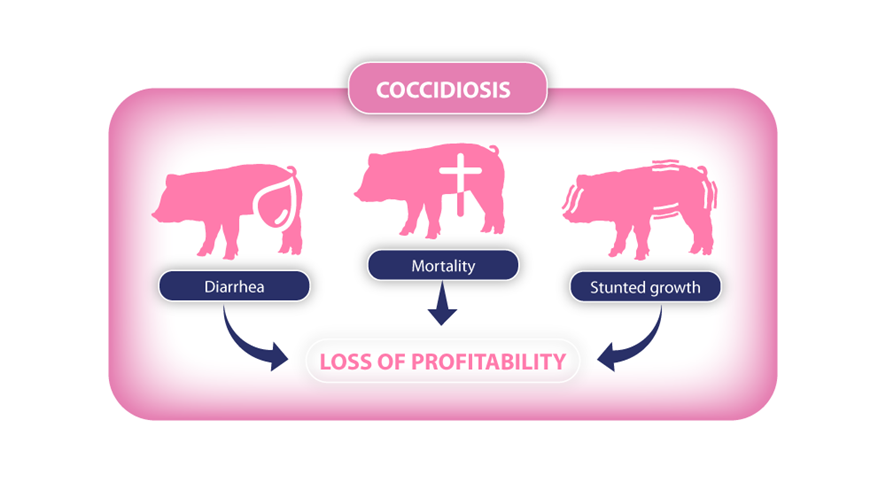10 October 2022
How is Coccidiosis in Pigs Contracted
How is Coccidiosis in Pigs Contracted
Coccidia are single cell protozoan parasite of the families Cystoisospora (Isospora), Cryptosporidium and Eimeria
Cystoisospora suis (Isaspora) is the main pathogen of piglets and is responsible for the most coccidial diarrhoea.
Understanding the life cycle of coccidia is crucial to implement the right preventive and control measures.
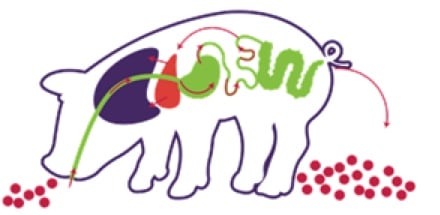
- Piglets get infected with coccidia when they ingest sporulated oocysts.
- Coccidia multiply rapidly in the gut lining, damaging a pig’s ability to absorb nutrients.
- Oocysts can remain in the environment for a long time and are hard to get rid of.
Piglets are infected during the first week of life following ingestion of oocysts that have sporulated in the environment, especially in high temperatures (32-35oC) and humidity conditions.
Did you know? Most piglets get infected in contaminated farrowing pens
There is some debate as to whether the sows contribute significantly to the infection; but proven- the main source of coccidia are the oocysts that are left behind by previous litters. Infected pigs can shed thousands of oocysts in their faeces over the course of the disease.
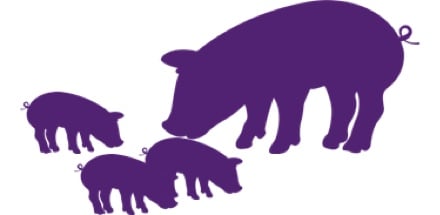
50% of piglets excret oocysts by the end of the 1st week and oocysts are seen in the faeces of piglets 5 days post infection
The ease of infection and extent of contamination explains why coccidiosis is present in so many farms
Each oocyst has the potential to destroy thousands or even millions of intestinal epithelial cells. Impact increased by other infections, such as Clostridium spp.
In a recent study conducted in major pig producing countries in Europe, over 70% of farms were positive for C. suis and around 50% of litters were affected.
Some authors1 believe that C. suis is ubiquitous, but because it is a difficult parasite to diagnose, we might not be seeing the whole picture.
-
1 Shrestha, A., Abd-Elfattah, A., Freudenschuss, B., Hinney, B., Palmieri, N., Ruttkowski, B. and Joachim, A. (2015). Cystoisospora suis – A Model of Mammalian Cystoisosporosis. Frontiers in Veterinary Science, 2(68). doi: 10.3389/fvets.2015.00068
What are the Symptoms of Coccidiosis
The main symptom of C. suis infection is scour in piglets (diarrhoea).
It is important to differentiate coccidiosis from other enteric pathologies that show yellowish diarrhoea and appear in the first weeks of life
To differentiate them, we might consider some points
- faeces consistency and blood presence
- the age at which diarrhoea outbreak takes place and
- response to treatment with different antimicrobials
Table 1 :Comparison of diarrhoea aspects according to the enteric pathology.
(adapted from Swine enteric colibacillosis: diagnosis, therapy and antimicrobial resistance/ Andrea Luppi)
| Disease/Etiological Agent | Age | Diarrhoea | Lethality |
|
Colibacillosis E.coli (ETEC) |
Most commonly from 0 to 4 days |
Yellowish, grey or slightly pink alkaline pH |
Yellowish, grey or slightly pink alkaline pH |
|
Clostridiosis C.perfrigens type C |
PA: 1 days A: 3 days SA: 7 days C: 10–14 days |
PA: watery yellowish bloody A: brown bloody SA: watery grey/yellow C: yellow/grey |
100% in PA and A forms |
|
Clostridiosis C.perfrigens type A |
Generally diarrhoea is observed within 48 h of birth |
Mucoid, pink without blood |
Generally low if not complicated |
|
Clostridiosis Clostridium difficile |
In the first week of life |
Pasty and yellow |
Variable. Up to 50% |
|
Coronavirus PEDV TGEV |
All |
Watery yellow/white/grey Watery yellow, white, grey, greenish; acid pH |
Differs between strains and between naïve and endemic infected herds. Very high (80–100%) in suckling piglets belonging to naïve infected herds |
|
Rotaviral enteritis Rotavirus |
From 1 to 5 weeks |
Watery, sometimes pasty. Acid pH |
Low (in endemic infected herds) <20% |
|
Coccidiosis Isospora suis |
Not before 5 days. More frequent around 14 days |
Yellow and pasty. Alkaline pH |
Very low or not observed |
Let’s sum up the symptoms and clinical manifestations of coccidiosis in pigs:
Main symptoms
Scour in piglets
Watery or creamy diarrhoea, white to yellow, foul odour
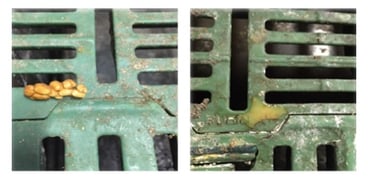 If the diarrhoea is severe, piglets become dehydrated, weak, and can die. Nevertheless, mortality is low
If the diarrhoea is severe, piglets become dehydrated, weak, and can die. Nevertheless, mortality is low
 Faeces pictures University of Veterinary Medicine, Vienna
Faeces pictures University of Veterinary Medicine, Vienna
Most pigs recover from coccidiosis, but by this point the damage has been done. Stunted growth, contamination of the pens with oocysts and subclinical infections are likely to cause significant losses to the farmer.
- Stunted growth: undersized piglets, most evident at weaning.
- Dehydration: weakened piglets, sunken eyes.
Signs in litter
- High morbidity: most, if not all piglets get sick.
- Onset of the disease is characteristic and an important clue for farmers and veterinarians. Scouring usually starts at days 7 to 10 of age, rarely 5
- Low mortality: few piglets die, some recover in just a few days.
Coinfections with rotavirus, E. coli and C. perfringens type A.
C. suis also makes piglets more susceptible to other pathogens, namely Clostridium perfringens type A, rotavirus and E. coli. Coinfections increase the mortality rate.
There is evidence that coccidia also changes the gut microbiome, making it easier for the dangerous, toxin-producing bacterium Clostridium perfringens and other pathogenic bacteria to thrive.
High mortality
What about Subclinical infections ?
One of the greatest concerns for pig farmers is the presence of subclinical infections. These do not have any clinical manifestations, other than poor performance (pigs continue to waste or underperform after weaning).
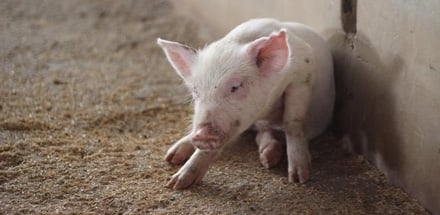
How is coccidia diagnosed?
Clinical history and symptoms identification can help you to suspect a coccidiosis infection at the beginning.
Pay attention to Diarrhea on the second and third week of age,not responding to ATB treatment.
To get a definitive diagnosis serial sampling is almost always necessary.
You may call your vet to perform Laboratory examination.
There are several techniques to see and count the number of oocysts in the faeces, in order to assess to confirm parasites and the severity of an outbreak.
- Flotation methods
- Autofluorescence method: oocysts show blue auto-fluoresce under UV light
Faecal examinations (individual piglets/litter) are required during the second week of age and one week later.
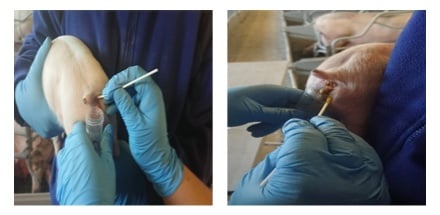
How to prevent Coccidiosis in pigs
There is no vaccine for coccidiosis in pigs in the market.
To control this disease, there are three methods at our disposal:
1. Hygiene
Hygiene is paramount. As discussed above, the main source of infection are contaminated environments.
- Daily removal of faeces is crucial, especially in hot and humid conditions that favour sporulation.
- Control pests which can spread oocysts, such as rodents and insects.
- Thoroughly clean pens between farrowings, especially slurry canals.
- Remove bedding frequently.
2. Disinfection
Oocysts are resistant to most disinfectants, which poses a new challenge for the pig farmer. Only cresol-based products are effective against coccidia.
- Use disinfectants with proven effectiveness against oocysts (ask your vet!).
- Steam-cleaning is effective. Flame guns have also been used, be mindful of your local regulations and think safety first
3. Coccidiostats
Coccidiostats are drugs that impede the development and shedding of coccidia.
Coccidiostats are effective for the control of infection.
- Metaphylactic administration of toltrazuril has also been shown to improve performance, due to its positive effect on subclinical infections. Important is timing of the treatment intervention in order to disrupt the development cycle of parasites. That is the reason why early intervention is more effective.
A single dose of toltrazuril can help prevent clinical coccidiosis. Some products contain toltrazuril and iron, to treat and prevent piglet iron deficiency anaemia while, at the same time, taking care of coccidia.
Treatment and control
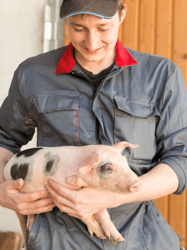 Once coccidia have colonised the gut lining, treatment is of little value.
Once coccidia have colonised the gut lining, treatment is of little value.
Sulphonamides have been used to treat coccidiosis, with poor results.
From the rational use of antibiotics on farm, control of the coccidiosis should not be based on use of ATB.
A common control practice was to add amprolium, monensin or oral sulfa to sow feed. This protocol is of doubtful value, and it is no longer permitted in all countries. Ask your vet for applicable regulations in your country!
Many veterinarians choose to treat coccidiosis with injected sulphonamides and provide supportive treatment for dehydration as needed. Scour caused by coccidia is not responsive to antibiotics, a sign that could aid in diagnosis by elimination.
Even if there’s not much we can do for an individual pig once scouring is present, we should provide metaphylactic treatment —giving medicine to all animals in a litter, even if they show no clinical signs.
Toltrazuril is the most effective coccidiostat at our disposal. It can be given orally or injected.
A strategy that has proven to be of preventive value is to treat suckling piglets with toltrazuril within the first week of life, with clear benefit of early administration during the first days after farrowing. Remember! Once the parasite colonises the gut, there is not much we can do! This prophylactic measure reduces scour, oocyst shedding and improves pig performance.
Injectable toltrazuril products can be effective in preventing coccidiosis with a single fixed dose, which minimises handling and saves labour.
Production Impact of Coccidiosis in Swine
This is the stat that matters: at weaning, pigs with coccidiosis will weigh 0.3 to 1 kg less than healthy peers. Not to mention losses due to mortality, cost of treatment, and the impact that oocyst shedding will have in future litters. The reason prophylactic toltrazuril products give the farmer so much peace of mind is that oocysts shedding is greatly reduced, thus avoiding further contamination and reducing the number of new cases.
Coccidiosis is a costly disease for the pig industry.

The damage that coccidia do to the gut lining renders it unable to absorb nutrients, which results in worse feed conversion rates (FCR), which in turn results in a much lower average daily gain (ADG). Days to slaughter increase, not only due to the lesser weight at weaning, but also because performance is impacted well into the growing-finishing stage.
Subclinical infections are of great concern because, due to lack of diagnosis, we do not really know what we are facing. There is growing evidence that C. suis might cause some pigs to fade post weaning. Some estimate the impact of subclinical infections to be about half that of clinical coccidiosis.
Conclusion
Labour saving
Coccidiosis is an economically important disease for pig farmers. Hygiene and disinfection are the most effective ways to reduce oocyst contamination in the environment.
Treatments have been rather unsuccessful but metaphylactic measures, such as a single dose of injectable toltrazuril, administered between days 1-3 of age, are effective for preventing and controlling coccidiosis in pigs.
Diagnosis is also important, but difficult. It should be oriented towards understanding the state of a farm and possible subclinical infections. Given the worldwide distribution of C. suis, it is safe to assume that, unless proven otherwise, coccidia are present.
